Optical Polarization Sensitive Ultra-Fast Switching and Photo-Electrical Device
Abstract
:1. Introduction
1.1. Ultra-Fast Electro-Optic Polarized Switch
1.2. The Original Photo-Electrical Device Concept
1.3. Modeling and Fabrication Parameters
1.4. Configurations, Key Parameters, and Corresponding Applications
1.4.1. Dual-Element (II) Configuration—Control Using Data Superposition
1.4.2. Triple-Element (III) Configuration—Complex Binary Structure
1.4.3. Multi-Elements (N) Configuration—Polarizing Transistors Circuitry
2. Materials and Methods
2.1. Numerical Initial Method
2.2. Analytical Complementary Method
3. Simulations Results, Configurations, and Applications
3.1. Turning off the SOIP2AM by a Slight Variation of Polarization
3.2. Switching Mode as a Function of the V-Groove Aperture
3.3. Switching Mode as a Function of the Polarization and the Wavelength
- Once again, the electron concentrations in the Si substrate are much higher, at the same opening size, for applied λ2 = 940 nm when compared to λ1 = 550 nm, whatever would be the polarization. This can be easily explained by the spectral responsivity of silicon [21].
- Moreover, if for a wavelength illumination of 550 nm, the electrons’ concentration curve at X-polarization remains lower than the Z-polarization’s one, the opposite phenomenon is observed for an illumination of wavelength 940 nm, for all the V-groove apertures. This may be explained by the interference figure close to the silicon groove edge which is destructive for Z polarization at 940 nm while constructive at 550 nm.
- Regarding such reversed concentration, one can use this advantage to reverse the SOIPAM operation mode of work, by changing the wavelength, enabling the device to stay closed for polarization in the X direction, and opened in the Z one.
3.4. Carriers Distribution in Slice Planes
3.5. Adjacent vs. Perpendicular Devices
4. Discussion and Complementary Analytical Model
4.1. MOSFET, SOIPAM, SOIP2AM, and N-SOIP2AM Evolution and Roadmap
4.2. Interferences Inside the Structure
4.3. Simulation vs. Modeling—The Complementary Analytical Model
5. Conclusions
Author Contributions
Funding
Acknowledgments
Conflicts of Interest
References
- Chai, Z.; Hu, X.; Wang, F.; Niu, X.; Xie, J.; Gong, Q. Ultrafast All-Optical Switching. Adv. Opt. Mater. 2017, 5, 1600665. [Google Scholar] [CrossRef]
- Jin, C.-Y.; Osamu, W. Photonic switching devices based on semiconductor nano-structures. J. Phys. D Appl. Phys. 2014, 47, 133001. [Google Scholar] [CrossRef] [Green Version]
- Agranat, J.; Secundo, L.; Golshani, N.; Razvag, M. Wavelength Selective Photonic Switching in Paraelectric KLTN. Opt. Mater. 2001, 18, 195–197. [Google Scholar] [CrossRef]
- Tian, H.; Zhou, Z.; Wang, H.; Liu, D. Optical properties of cubic KLTN single crystal. Opt. Mater. 2008, 31, 106–109. [Google Scholar] [CrossRef]
- Zhao, Y.; Qian, C.; Qiu, K.; Gao, Y.; Xu, X. Ultrafast optical switching using photonic molecules in photonic crystal waveguides. Opt. Express 2015, 23, 9211–9220. [Google Scholar] [CrossRef] [PubMed] [Green Version]
- Grinblat, G.; Nielsen, M.P.; Dichtl, P.; Li, Y.; Oulton, R.F.; Maier, S.A. Ultrafast sub–30-fs all-optical switching based on gallium phosphide. Sci. Adv. 2019, 5, eaaw3262. [Google Scholar] [CrossRef] [PubMed] [Green Version]
- Abraham, D.; Chelly, A.; Shappir, J.; Rosenbluh, M.; Zalevsky, Z. Silicon on insulator photo-activated modulator. Microelectron. J. 2008, 39, 1429–1432. [Google Scholar] [CrossRef]
- Abraham, D.; Chelly, A.; Shappir, J.; Zalevsky, Z. Hybrid optical and electrical reconfigurable logic gates based on silicon on insulator technology. J. Photonics Nanostructures-Fundam. Appl. (PNFA) 2011, 9, 35–41. [Google Scholar] [CrossRef]
- Abraham, D.; Zalevsky, Z.; Chelly, A.; Shappir, J. Fabrication of vertically positioned silicon on insulator photo-activated modulator. Photonics Nanostructures-Fundam. Appl. (PNFA) 2009, 7, 190–197. [Google Scholar] [CrossRef]
- Zev, A.; Chelly, A.; Karsenty, A.; Zalevsky, Z. Development, simulation and characterization of nanoscale silicon on insulator photo-activated modulator (SOIPAM) hybrid device. In Proceedings of the 2015 International Conference on Optical MEMS and Nanophotonics (OMN), Jerusalem, Israel, 2–6 August 2015. [Google Scholar]
- Zev, A.; Karsenty, A.; Chelly, A.; Zalevsky, Z. Nanoscale Silicon-On-Insulator Photo-Activated Modulator Building Block for Optical Communication. IEEE Photonics Technol. Lett. 2016, 28, 569–572. [Google Scholar] [CrossRef]
- Mandelbaum, Y.; Zev, A.; Chelly, A.; Zalevsky, Z.; Karsenty, A. Study of the Photo and Thermo-Activation Mechanisms in Nanoscale SOI Modulator. J. Sens. 2017, 2017, 9581976. [Google Scholar] [CrossRef]
- Mandelbaum, Y.; Gadasi, I.; Zev, A.; Chelly, A.; Zalevsky, Z.; Karsenty, A. Small Signals’ Study of Thermal Induced Current in Nanoscale SOI Sensor. J. Sens. 2017, 2017, 1961734. [Google Scholar] [CrossRef] [Green Version]
- Belhassen, J.; Frisch, A.; Kapellner, Y.; Zalevsky, Z.; Karsenty, A. V-groove-shaped silicon-on-insulator photopolarized activated modulator (SOIP2AM): A polarizing transistor. J. Opt. Soc. Am. A 2020, 37, 46–55. [Google Scholar] [CrossRef]
- Biswas, K.; Kal, S. Etch characteristics of KOH, TMAH and dual doped TMAH for bulk micromachining of silicon. Microelectron. J. 2006, 37, 519–525. [Google Scholar] [CrossRef]
- Chelly, A.; Cohen, Y.; Sa’ar, A.; Shappir, J. Pyramid-shaped silicon photodetector with subwavelength aperture. IEEE Trans. Electron. Devices 2002, 49, 986–990. [Google Scholar] [CrossRef]
- Comsol Multi-Physics Software Package Website. Available online: https://www.comsol.com/ (accessed on 30 October 2019).
- Matlab Software Package Website, MathWorks. Available online: https://www.mathworks.com/products/matlab.html (accessed on 30 October 2019).
- Strang, G.; Fix, G.J. An Analysis of the Finite Element Method, 2nd ed.; Wellesley-Cambridge Press: Wellesley, MA, USA, 2008. [Google Scholar]
- Karsenty, A.; Mandelbaum, Y. Computer Algebra Challenges in Nanotechnology: Accurate Modeling of nanoscale electro-optic devices using Finite Elements Method. Math. Comput. Sci. 2019, 13, 117–130. [Google Scholar] [CrossRef]
- Honsberg, C.; Bowden, S. Optical Properties of Silicon. PV.Education.org. Available online: https://www.pveducation.org/pvcdrom/materials/optical-properties-of-silicon (accessed on 30 October 2019).
- Eckhouse, V.; Zalevsky, Z.; Konforti, N.; Mendlovic, D. Sub wavelength structure imaging. Opt. Eng. 2004, 43, 2462–2468. [Google Scholar] [CrossRef]
- Eckhouse, V.; Zalevsky, Z.; Mendlovic, D. Dynamic sub wavelength encryption. SPIE Math. Data/Image Coding Compress. Encryption V Appl. 2003, 4793, 293–300. [Google Scholar]
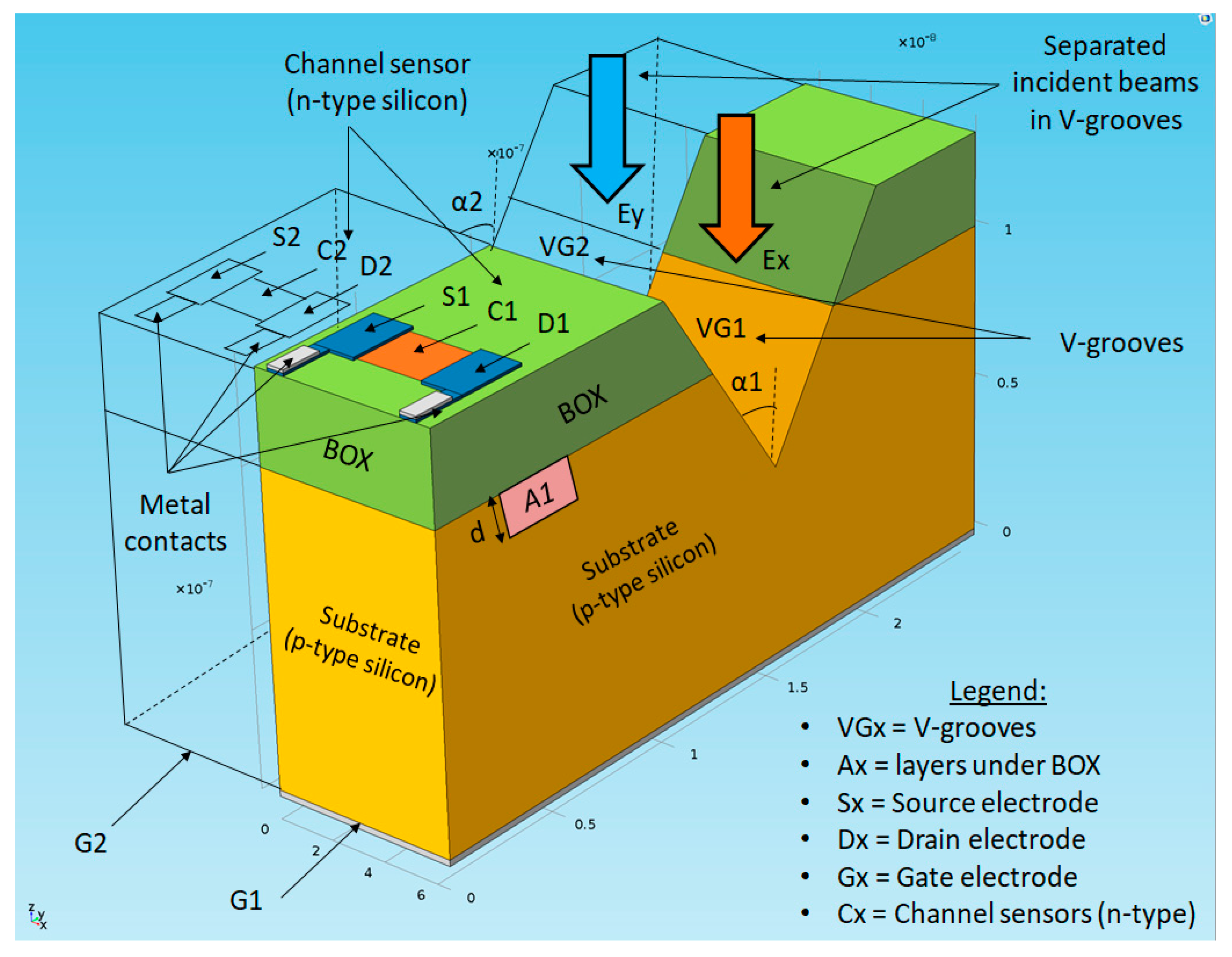
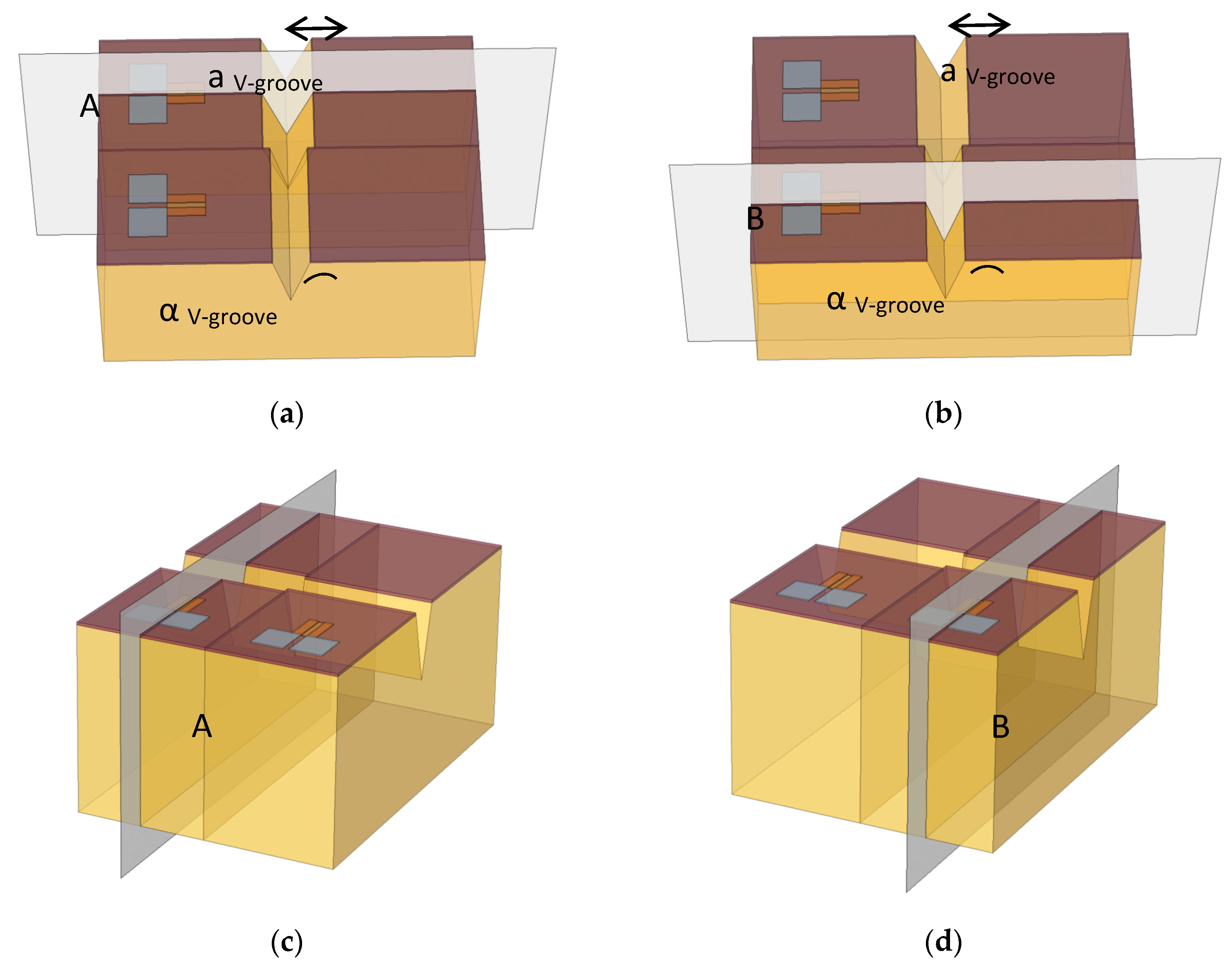
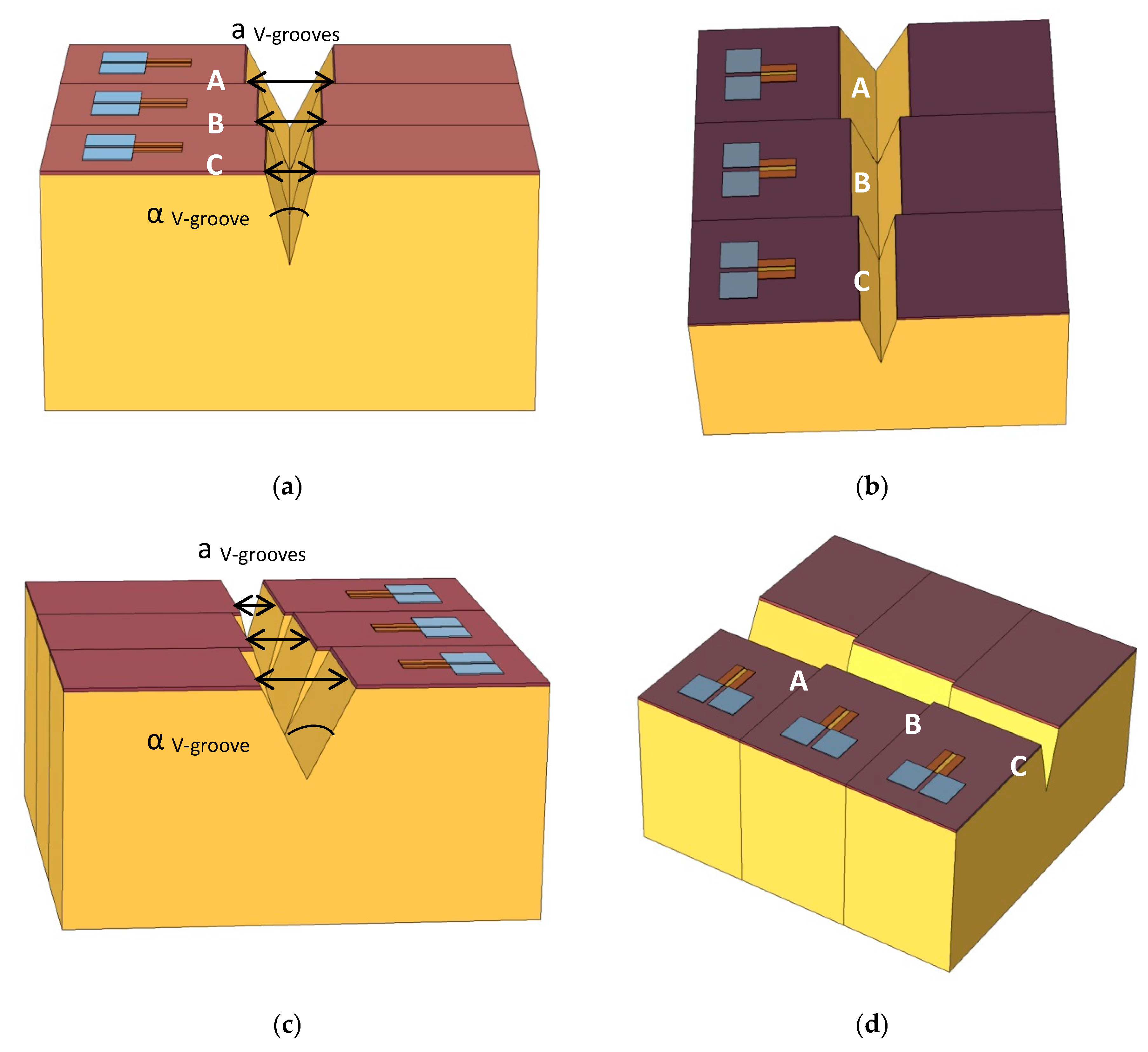
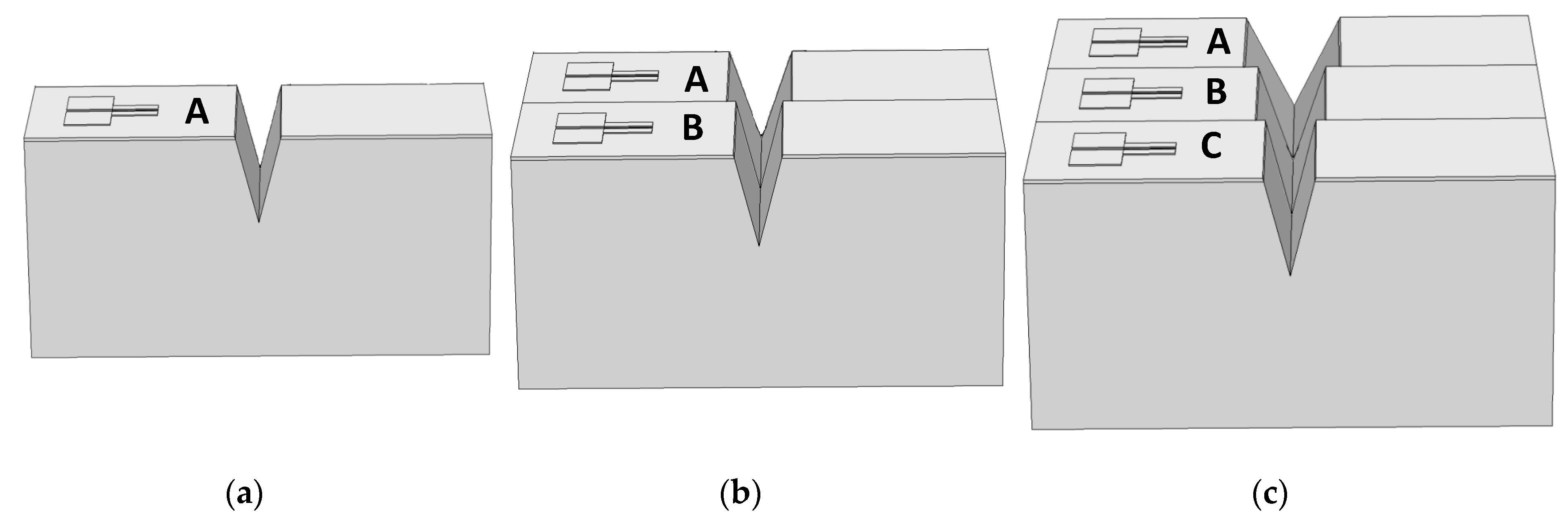
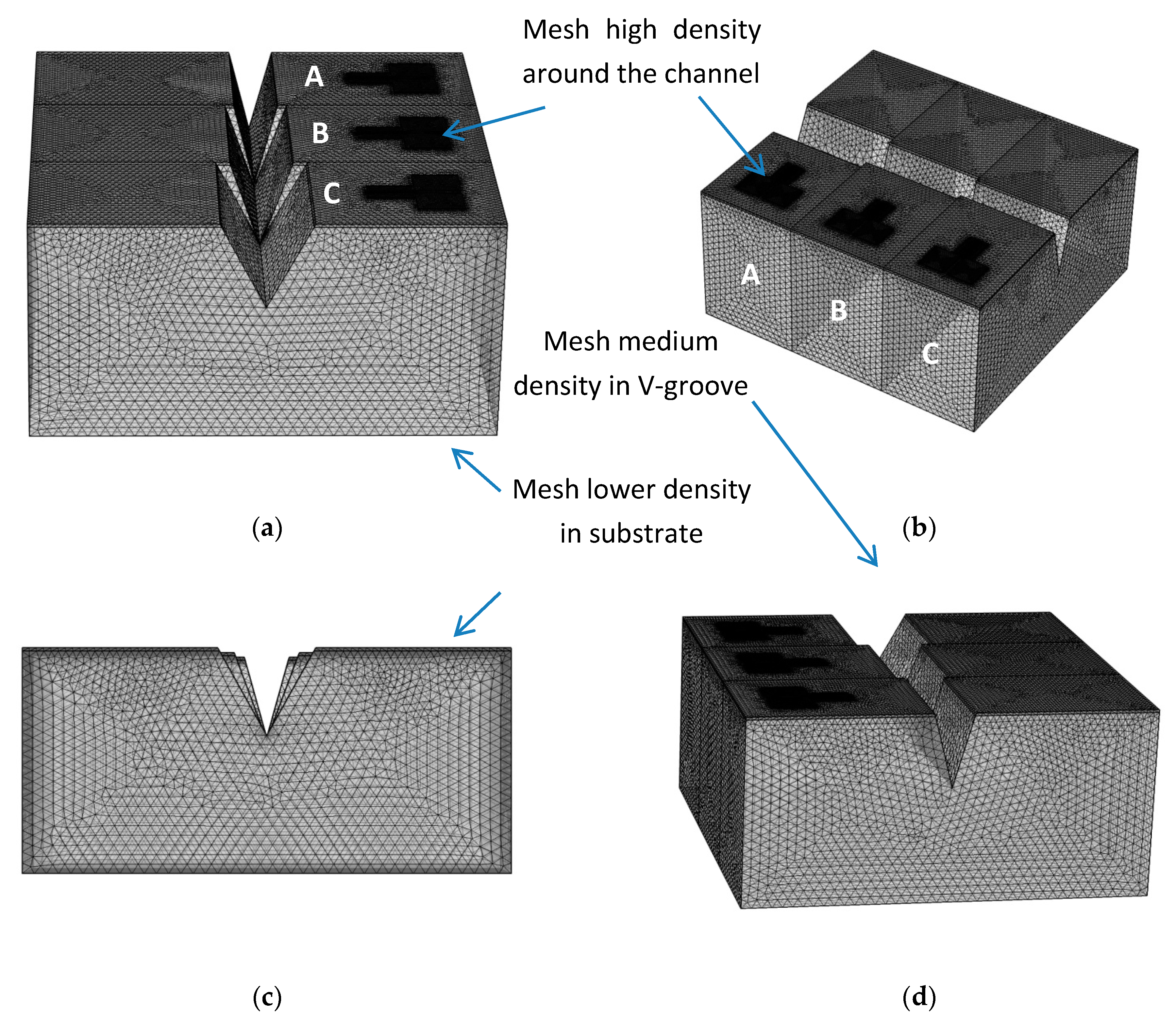

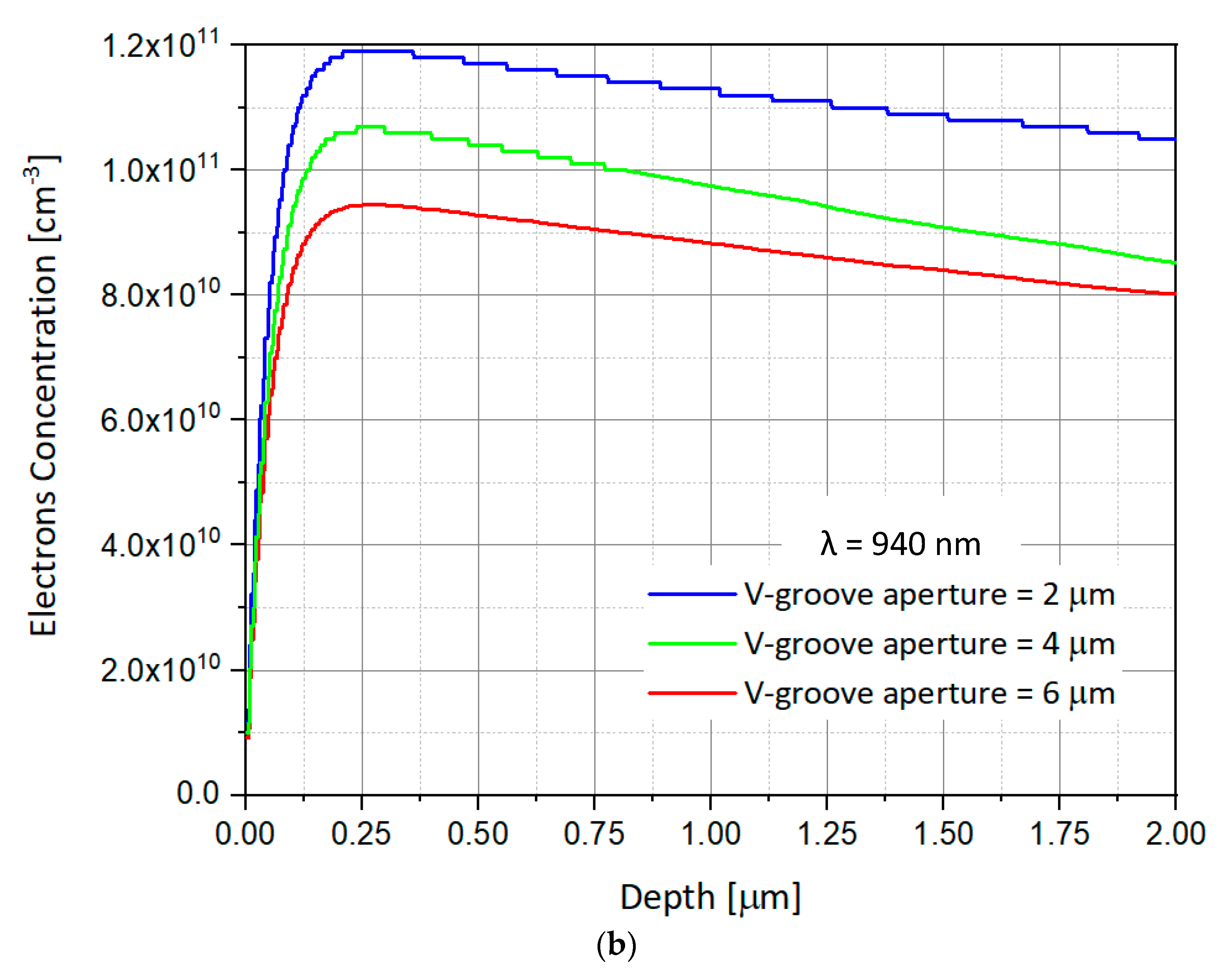
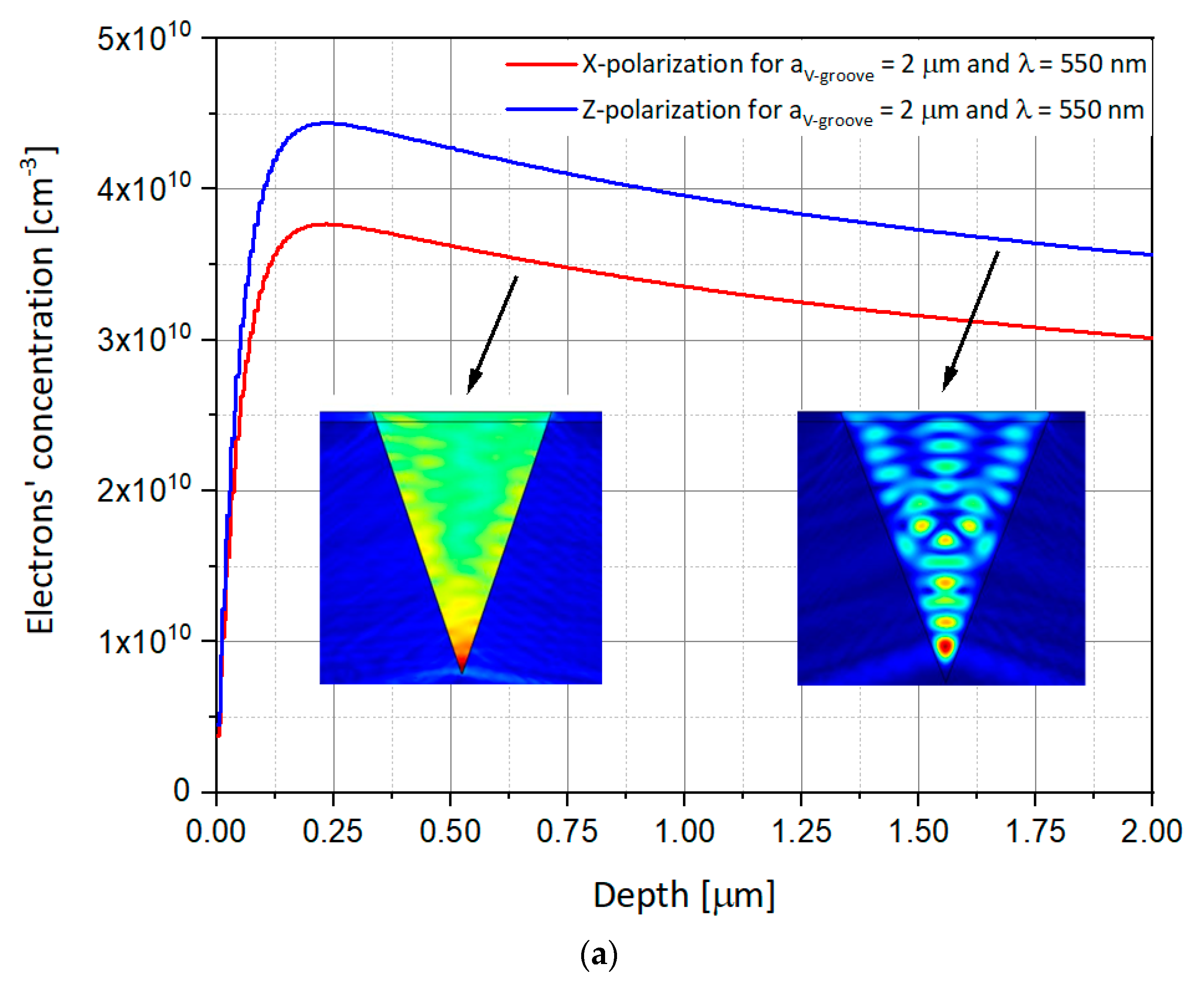
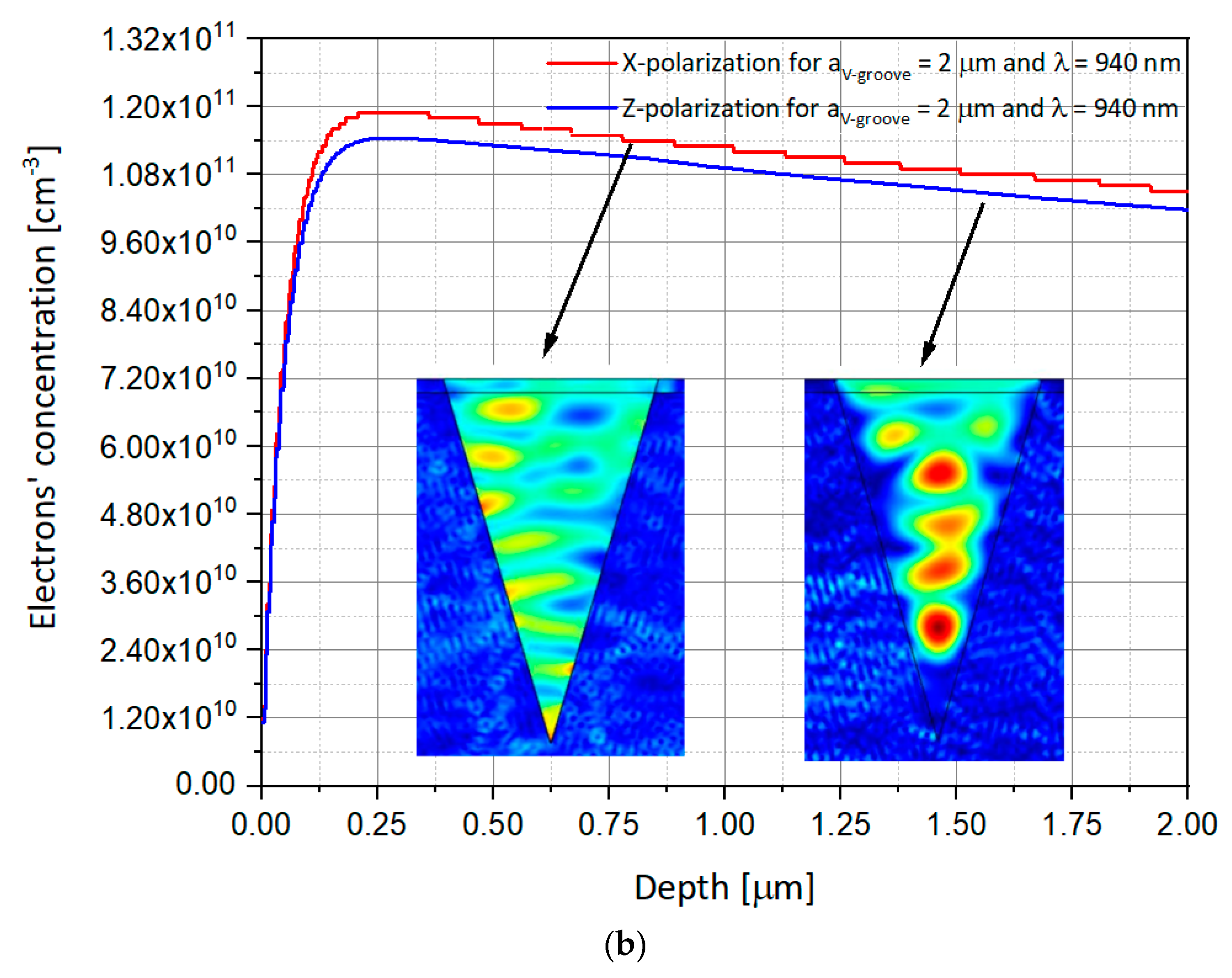
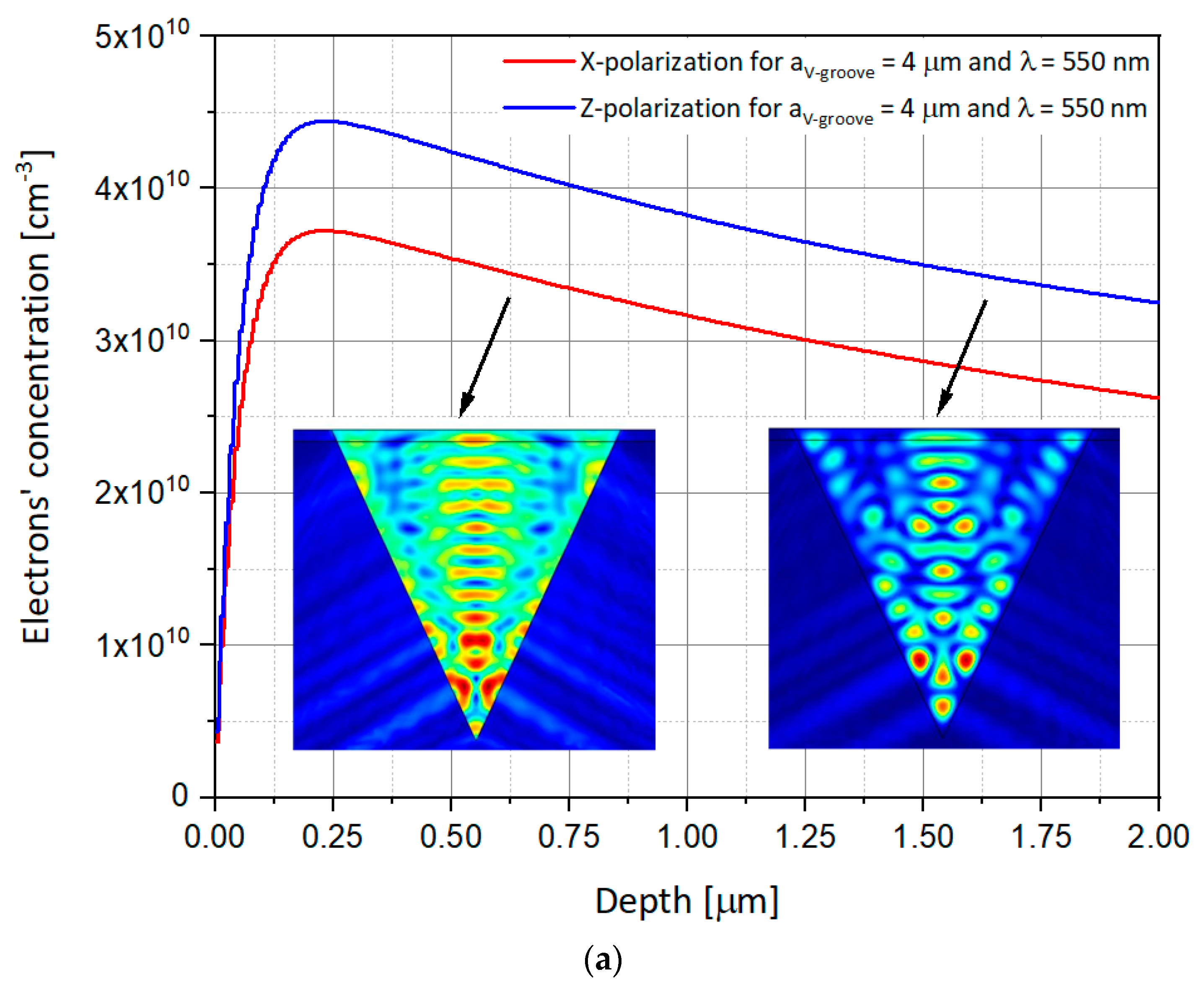
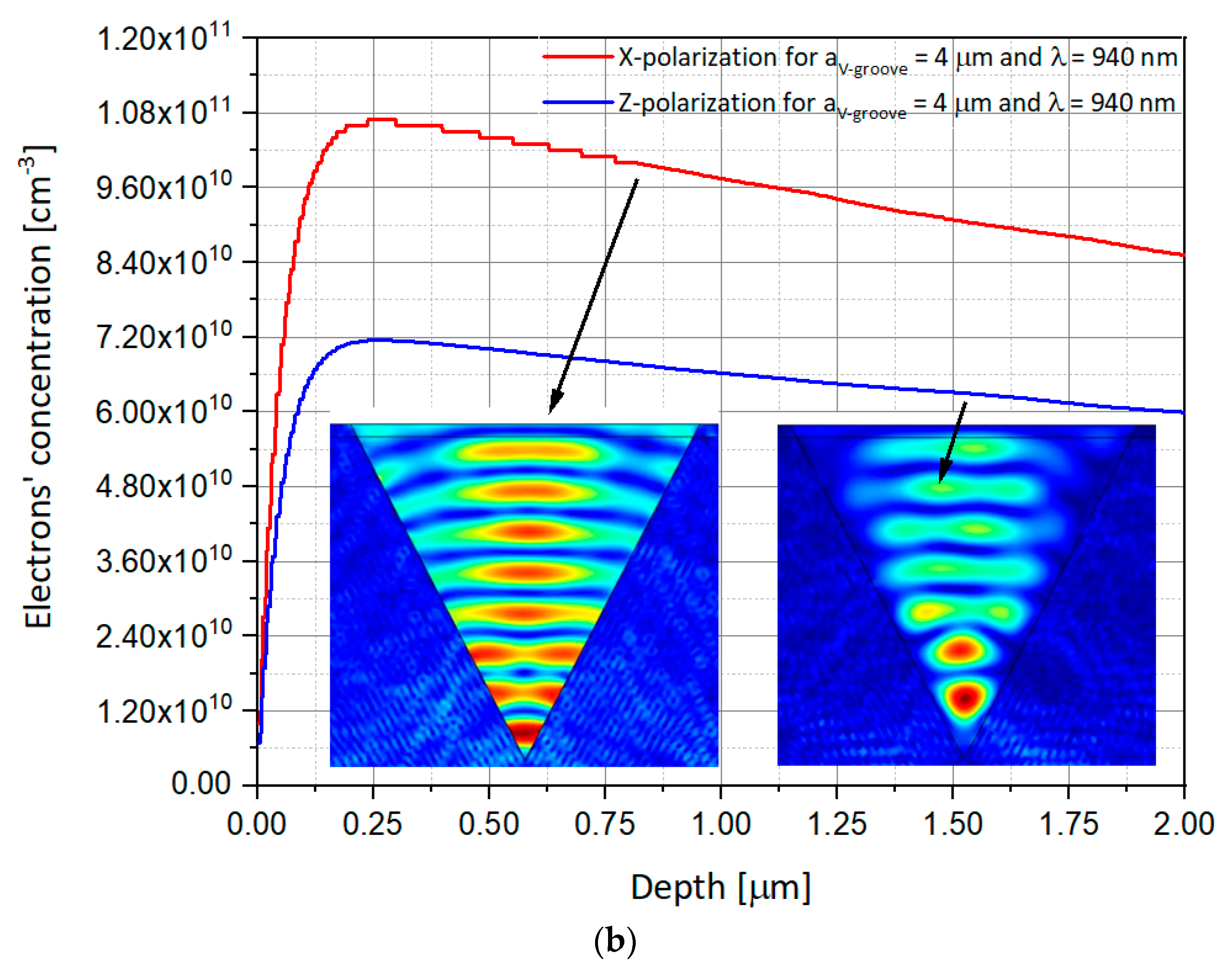
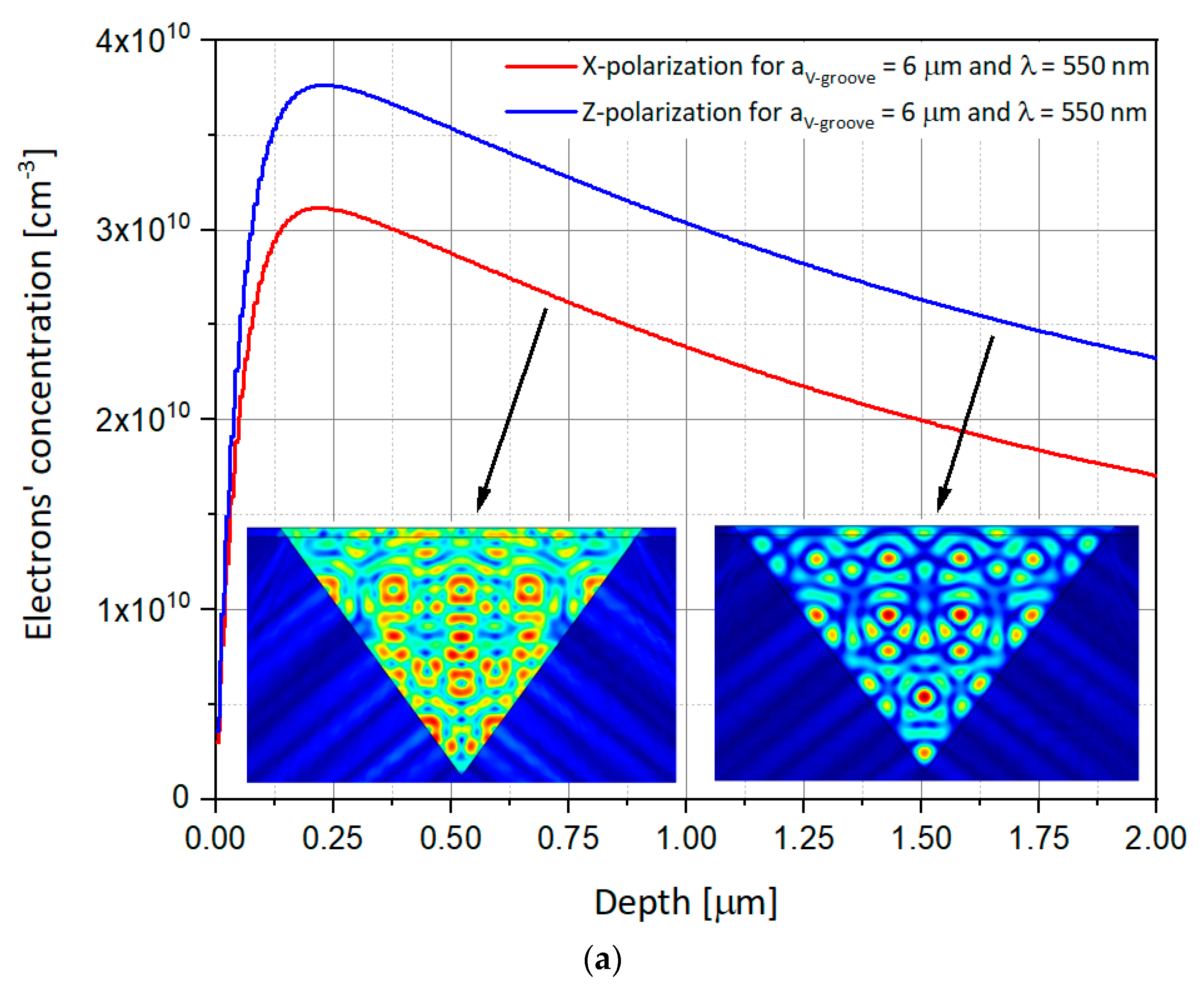

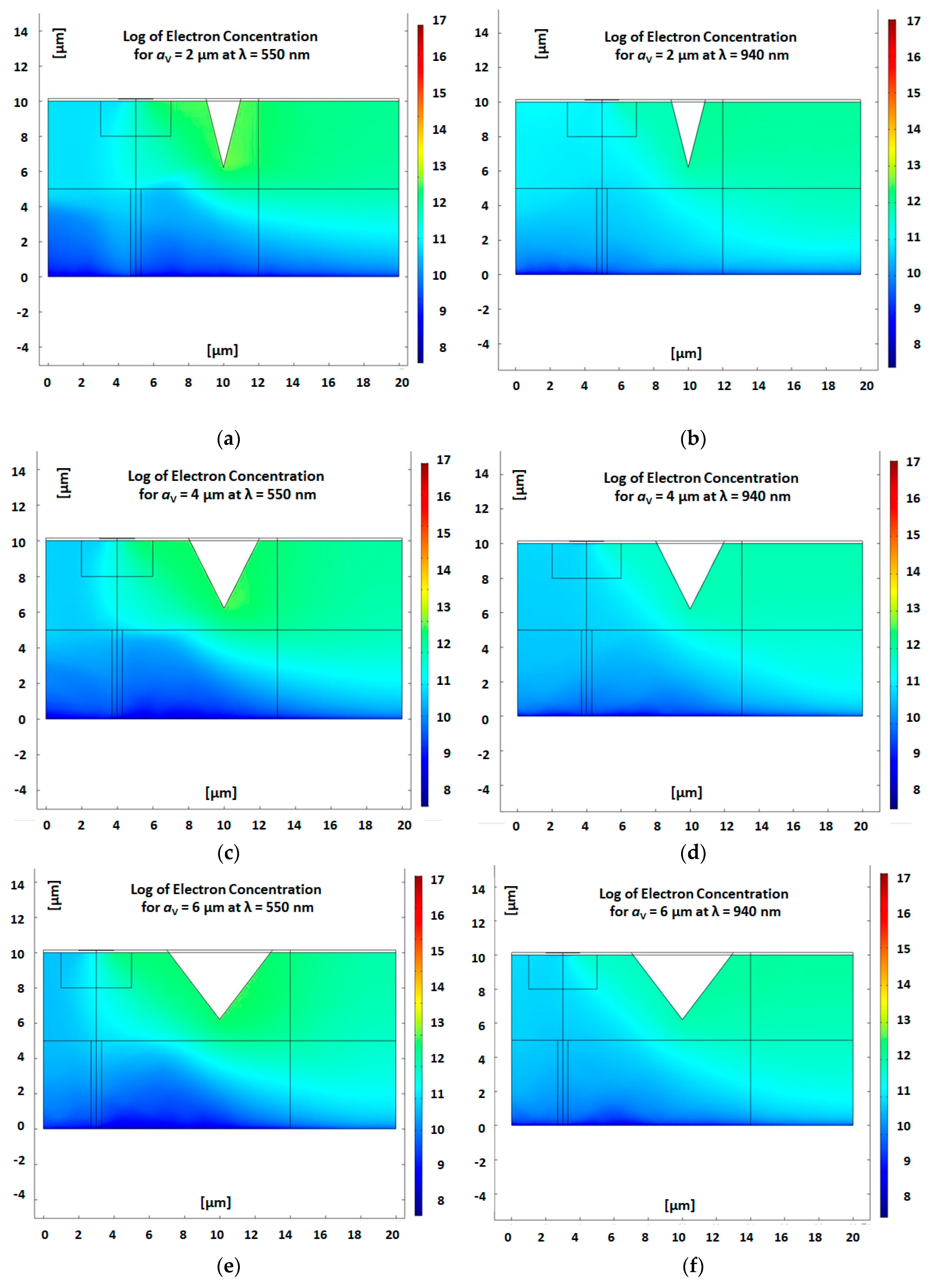
| Parameter | Definition | Value |
|---|---|---|
| Device parameters | ||
| W Silicon | Substrate width | 20 µm |
| L Silicon | Substrate length | 7 µm |
| H Silicon | Substrate height | 10 µm |
| L V-groove | V-groove length | 2.78 µm |
| H V-groove | V-groove height | 3.94 µm |
| t box | BOX thickness | 150 nm |
| t n = t channel | Channel thickness | 30 nm |
| L channel | Channel length (Source-Drain) | 300 nm |
| W channel | Channel width | 2 µm |
| ND | n-doped channel donors (P) concentration | ~1.1017 cm−3 |
| NA | p-doped substrate acceptors (B) concentration | ~1.1015 cm−3 |
| The setup parameters: | ||
| VG | Gate voltage | −1 V |
| VS | Source voltage | 0 V |
| VD | Drain voltage | 1 V |
| P in | Laser power | 10 mW |
| λ | Wavelength | 550 nm, 940 nm |
| a V-groove | V-groove aperture | a1 = 2 µm, a2 = 4 µm, a3 = 6 µm |
| α V-groove | V-groove angle | α1 = 28.48°, α2 = 53.83°, α3 = 74.57° |
| Measured parameters: | ||
| Maximum electron concentration in substrate | 3.75 × 1010 to 1.19 × 1011 cm−3 | |
© 2019 by the authors. Licensee MDPI, Basel, Switzerland. This article is an open access article distributed under the terms and conditions of the Creative Commons Attribution (CC BY) license (http://creativecommons.org/licenses/by/4.0/).
Share and Cite
Belhassen, J.; Zalevsky, Z.; Karsenty, A. Optical Polarization Sensitive Ultra-Fast Switching and Photo-Electrical Device. Nanomaterials 2019, 9, 1743. https://doi.org/10.3390/nano9121743
Belhassen J, Zalevsky Z, Karsenty A. Optical Polarization Sensitive Ultra-Fast Switching and Photo-Electrical Device. Nanomaterials. 2019; 9(12):1743. https://doi.org/10.3390/nano9121743
Chicago/Turabian StyleBelhassen, Jérémy, Zeev Zalevsky, and Avi Karsenty. 2019. "Optical Polarization Sensitive Ultra-Fast Switching and Photo-Electrical Device" Nanomaterials 9, no. 12: 1743. https://doi.org/10.3390/nano9121743






